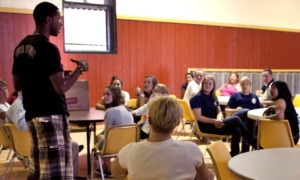Author(s): MDRC
- Louisa Treskon
- Kyla Wasserman
- Vicky Ho
Published: September 2019
Report Intro/Brief:
“The Learn and Earn to Achieve Potential (LEAP)TM initiative, a nationwide project of the Annie E. Casey Foundation, aims to improve education and employment outcomes for young people ages 15 to 25 who have been involved in the child welfare and justice systems or who are experiencing homelessness. Young people eligible for LEAP are likely to be disconnected from school and work, and face added challenges that stem directly from their systems involvement or homelessness, including disrupted schooling, housing instability, limited family support, and trauma. LEAP seeks to reduce the inequalities in life chances and outcomes that affect this population, with the goal of helping these young people reach their full potential by connecting them to postsecondary and career pathways.
LEAP operationalizes two education- and employment-focused program models to help young people at different stages along their educational and employment pathways. One program, Jobs for America’s Graduates, or JAG, targets young people who have not completed high school. JAG’s goal is to help these individuals obtain a high school credential and to equip them with the work and life skills they need to land quality jobs or acquire a postsecondary education. The second, JFF’s Back on Track program, aims to help young people transition to postsecondary education and persist through their crucial first year of college or advanced training.
Ten grantees in eight states are implementing LEAP, each in multiple locations. This report presents implementation, outcomes, and cost research findings from MDRC’s evaluation of the grantees’ LEAP programs, which focused on the early years of the initiative.
Key Findings
- Strategic partnerships with public agencies and other organizations are essential to reaching young people who are eligible for LEAP, aligning resources, and opening access to services.
- The LEAP population faces a set of systemic and structural barriers that are unique to their involvement in the child welfare and justice systems, which can hinder their progress in programs designed to elevate their educational and economic opportunities. To better serve participants, LEAP programs adapted how they delivered services to mitigate these barriers and make it easier for young people to participate.
- Back on Track participants had high engagement in the program: Most received a set of services to prepare them for success in postsecondary education or training, 68 percent enrolled in postsecondary education or a job-training program, and 40 percent persisted in school and completed their first year.
- Most JAG enrollees received the program’s key services, but more than half did not complete the program. Of those who completed the program’s Active Phase, in which the majority of services are delivered, 40 percent earned their high school credential and 76 percent were employed or in school at one point during the first six months of follow-up.
- The costs of providing LEAP services varied by program structure and local context. Costs per participant, including outreach and follow-up, ranged from $5,300 to $7,300.
LEAP program staff members found early on that they needed to adapt their service delivery plan to keep young people engaged for the full program period. This calls out the need for more research into how programs can sustain the engagement of young people on the long path to attaining a high school credential or postsecondary degree. This report details some of the adaptations that LEAP programs developed to promote engagement, but a longer follow-up period is needed to assess whether these adaptations were successful.”
>>> CLICK HERE to see all of Youth Today’s REPORT LIBRARY































